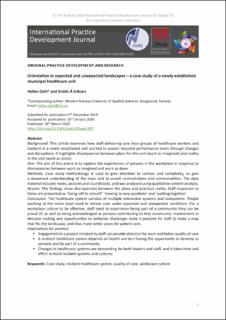| dc.contributor.author | Dahl, Hellen | |
| dc.contributor.author | Eriksen, Kristin Ådnøy | |
| dc.coverage.spatial | Norway | en_US |
| dc.date.accessioned | 2020-06-10T10:58:28Z | |
| dc.date.available | 2020-06-10T10:58:28Z | |
| dc.date.created | 2020-04-29T08:52:22Z | |
| dc.date.issued | 2020 | |
| dc.identifier.citation | Dahl, H., & Eriksen, K. Å. (2020). Orientation in expected and unexpected landscapes – a case study of a newly established municipal healthcare unit. International Practice Development Journal, 10(Suppl), 1-13. | en_US |
| dc.identifier.issn | 2046-9292 | |
| dc.identifier.uri | https://hdl.handle.net/11250/2657525 | |
| dc.description.abstract | Background: This article examines how staff delivering care (two groups of healthcare workers and leaders) in a newly established unit worked to sustain required performance levels through changes and disruptions. It highlights discrepancies between plans for the unit (work as imagined) and reality in the unit (work as done).
Aim: The aim of this article is to explore the experiences of persons in the workplace in response to discrepancies between work as imagined and work as done.
Methods: Case study methodology is used to give attention to context and complexity, to gain a deepened understanding of the topic and to unveil contradictions and commonalities. The data material includes notes, pictures and soundtracks, and was analysed using qualitative content analysis.
Results: The findings show discrepancies between the plans and practical reality. Staff responses to these are presented as ‘being left to oneself’ ‘moving to new positions’ and ‘walking together’.
Conclusion: The healthcare system consists of multiple interactive systems and subsystems. People working at the micro level need to deliver care under expected and unexpected conditions. For a workplace culture to be effective, staff need to experience being part of a community they can be proud of, as well as being acknowledged as persons contributing to that community. Involvement in decision making and opportunities to verbalise challenges make it possible for staff to make a map that fits the landscape, and thus make better plans for patient care.
Implications for practice:
Engagement in a project initiated by staff can provide direction for work and better quality of care
A resilient healthcare system depends on health workers having the opportunity to develop as persons and be part of a community
Changes in healthcare systems are demanding for both leaders and staff, and it takes time and effort to build resilient systems and cultures | en_US |
| dc.language.iso | eng | en_US |
| dc.publisher | Foundation of Nursing Studies | en_US |
| dc.rights | Navngivelse-Ikkekommersiell 4.0 Internasjonal | * |
| dc.rights.uri | http://creativecommons.org/licenses/by-nc/4.0/deed.no | * |
| dc.subject | case study | en_US |
| dc.subject | quality of care | en_US |
| dc.subject | resilient healthcare system | en_US |
| dc.subject | workplace culture | en_US |
| dc.title | Orientation in expected and unexpected landscapes – a case study of a newly established municipal healthcare unit | en_US |
| dc.type | Peer reviewed | en_US |
| dc.type | Journal article | en_US |
| dc.description.version | publishedVersion | en_US |
| dc.rights.holder | © The Authors 2020 | en_US |
| dc.subject.nsi | VDP::Medisinske Fag: 700::Helsefag: 800::Helsetjeneste- og helseadministrasjonsforskning: 806 | en_US |
| dc.source.pagenumber | 13 | en_US |
| dc.source.volume | 10 | en_US |
| dc.source.journal | International Practice Development Journal | en_US |
| dc.identifier.doi | https://doi.org/10.19043/ipdj.10Suppl.007 | |
| dc.identifier.cristin | 1808560 | |
| cristin.ispublished | true | |
| cristin.fulltext | original | |
| cristin.qualitycode | 1 | |

